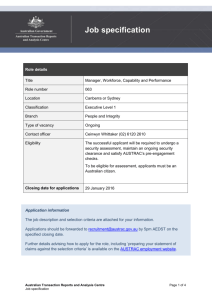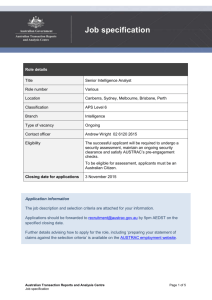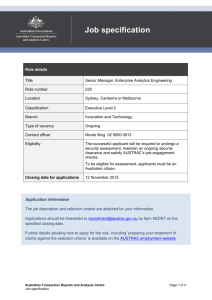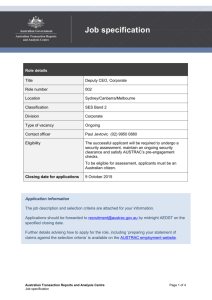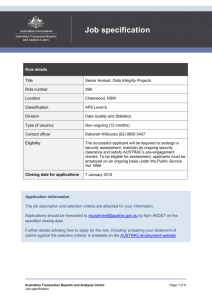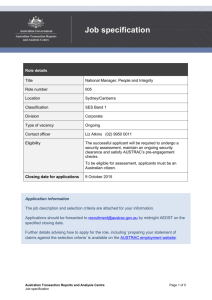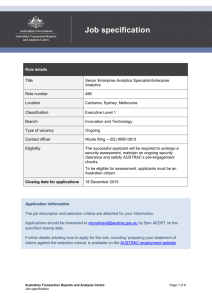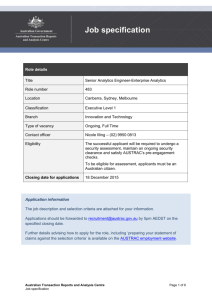Supervisory Framework
advertisement
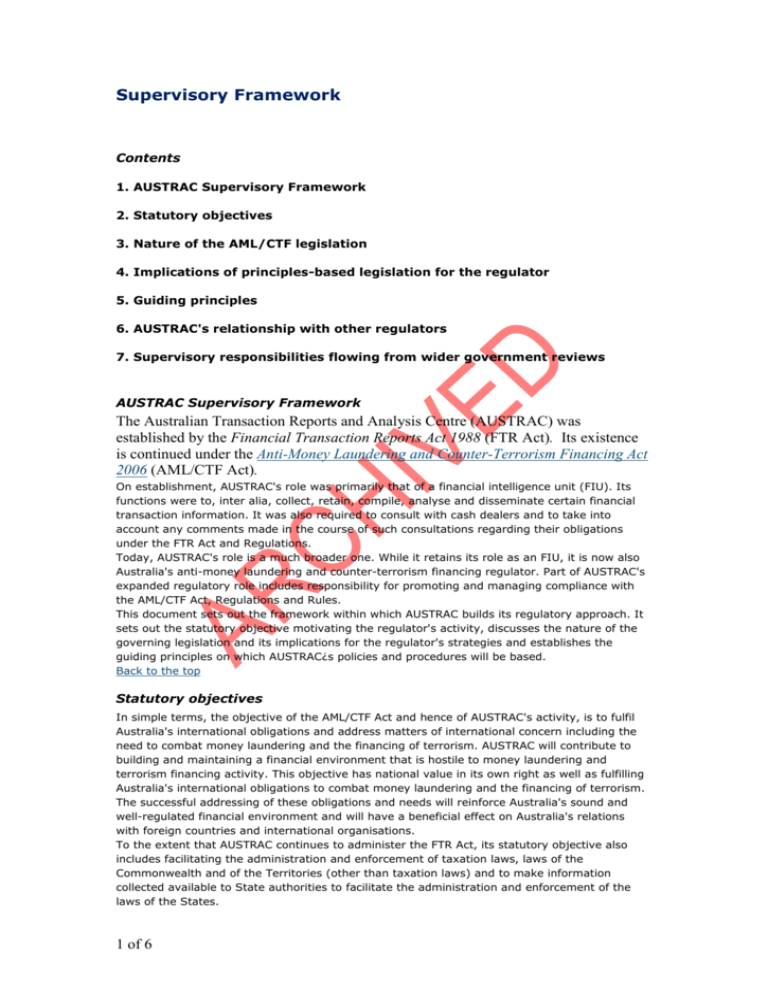
Supervisory Framework Contents 1. AUSTRAC Supervisory Framework 2. Statutory objectives 3. Nature of the AML/CTF legislation 4. Implications of principles-based legislation for the regulator 5. Guiding principles 6. AUSTRAC's relationship with other regulators 7. Supervisory responsibilities flowing from wider government reviews AUSTRAC Supervisory Framework The Australian Transaction Reports and Analysis Centre (AUSTRAC) was established by the Financial Transaction Reports Act 1988 (FTR Act). Its existence is continued under the Anti-Money Laundering and Counter-Terrorism Financing Act 2006 (AML/CTF Act). On establishment, AUSTRAC's role was primarily that of a financial intelligence unit (FIU). Its functions were to, inter alia, collect, retain, compile, analyse and disseminate certain financial transaction information. It was also required to consult with cash dealers and to take into account any comments made in the course of such consultations regarding their obligations under the FTR Act and Regulations. Today, AUSTRAC's role is a much broader one. While it retains its role as an FIU, it is now also Australia's anti-money laundering and counter-terrorism financing regulator. Part of AUSTRAC's expanded regulatory role includes responsibility for promoting and managing compliance with the AML/CTF Act, Regulations and Rules. This document sets out the framework within which AUSTRAC builds its regulatory approach. It sets out the statutory objective motivating the regulator's activity, discusses the nature of the governing legislation and its implications for the regulator's strategies and establishes the guiding principles on which AUSTRAC¿s policies and procedures will be based. Back to the top Statutory objectives In simple terms, the objective of the AML/CTF Act and hence of AUSTRAC's activity, is to fulfil Australia's international obligations and address matters of international concern including the need to combat money laundering and the financing of terrorism. AUSTRAC will contribute to building and maintaining a financial environment that is hostile to money laundering and terrorism financing activity. This objective has national value in its own right as well as fulfilling Australia's international obligations to combat money laundering and the financing of terrorism. The successful addressing of these obligations and needs will reinforce Australia's sound and well-regulated financial environment and will have a beneficial effect on Australia's relations with foreign countries and international organisations. To the extent that AUSTRAC continues to administer the FTR Act, its statutory objective also includes facilitating the administration and enforcement of taxation laws, laws of the Commonwealth and of the Territories (other than taxation laws) and to make information collected available to State authorities to facilitate the administration and enforcement of the laws of the States. 1 of 6 Back to the top Nature of the AML/CTF legislation The AML/CTF Act is a principles-based piece of legislation. It sets out broad obligations which reporting entities and others affected by the legislation must meet, but leaves the methods of meeting those obligations to be decided by those on whom the obligations fall. This approach is based on the assumption that businesses are best placed to know their products, operating structure and business environment. As a result, they are also best placed to assess the risks that their business will be used for money laundering or terrorism financing purposes. They will, it follows, be able to tailor mitigation strategies to the circumstances of their products, business structure, financial resources and staff. Furthermore, principles-based legislation provides the best approach for a regulatory environment to remain relevant and effective in a rapidly changing, sophisticated, global business environment. Having established the objectives and broad obligations, it is up to business to adjust their AML/CTF programs and strategies to keep up with the changing business environments in which they operate. It also requires AUSTRAC to understand the changes in the global environment in order to remain confident that its reporting entities are successfully meeting their AML/CTF obligations. While principles-based legislation has numerous advantages it does entail considerable work on the part of the regulator and reporting entities in order to understand and implement practical solutions which will achieve legislative objectives. Some entities consider the lack of certainty implicit in a principles based approach to be a distinct disadvantage. There is no easy `tick-thebox' path towards achieving compliance. Reporting entities and others under the regime must make a concerted effort to know the law and their obligations, know their business and its AML/CTF risks and then make decisions about how to manage and mitigate those risks. It may be tempting to advocate the creation of Rules to give certainty and definition to every possible aspect of the law. However, while the AML/CTF Act makes numerous references to AML/CTF Rules, AUSTRAC will only make Rules where either the Act requires a Rule to be made or practical experience reveals that the legislation's intended outcomes will not be achieved unless a Rule is made. AUSTRAC will, however, assist reporting entities to know, understand and comply with their AML/CTF obligations through guidance, education and awareness raising programs. The benefits associated with principles-based legislation, ie its flexibility in a rapidly changing business environment and its ability to cover a wide range of differing reporting entities, are substantial and the concerns associated with uncertainty can be managed with well planned and executed guidance and education strategies. Back to the top Implications of principles-based legislation for the regulator Principles-based legislation requires that the regulator keeps up to date with technology advances, market developments and international trends in good regulatory practice. The regulator needs to be aware of the practical impact of the decisions it makes and the likely reactions that may occur. With limited resources and a rapidly changing economic and social environment, AUSTRAC believes that it will maximise its effectiveness by building stronger and more cooperative relationships with the reporting entities it regulates and by nurturing a culture of voluntary compliance with the law. It will build respect from regulated entities by being active, visible and, where necessary, assertive. AUSTRAC will consult regularly in the development of its AML/CTF Rules and guidance and will liaise with reporting entities, partner agencies and other interested parties on issues such as risk management, compliance performance, market developments and the protection of commercial confidentiality and personal privacy. AUSTRAC's expectations of its stakeholders will be made 2 of 6 clear and in turn it will listen to suggestions and feedback. To facilitate the consultation, AUSTRAC will establish the AUSTRAC Financial Industry Consultative Forum and the Gaming Industry Consultative Forum. Other formal and informal consultation channels will be instituted as stakeholder requirements in that regard become clearer. Where there is clear evidence of chronic or serious non-compliance with the law, AUSTRAC will not hesitate to act firmly and clearly, including where necessary by way of measured enforcement action. Decisive and soundly based enforcement action upholds the law and encourages voluntary compliance through its education/deterrent effect. Back to the top Guiding principles AUSTRAC has adopted four guiding principles on which it has based its approach to its regulatory task. These principles are efficiency, equity, integrity and transparency. These basic principles lie behind many of the matters stated in subsection 212(3) of the AML/CTF Act which the AUSTRAC CEO must take into account when performing his functions. Efficiency As with most regulators AUSTRAC has limited resources with which to meet an almost unlimited task. It is acknowledged by regulators worldwide that the most effective way to meet their regulatory tasks with limited resources is to adopt a risk-based approach to their activities. Such an approach enables regulators to focus their time and resources on those areas most likely to threaten their regulatory objective. Risk-based regulatory frameworks have become best practice. A risk-based approach has been used to conduct AUSTRAC inspections under the FTR Act and will be continued and enhanced under the AML/CTF Act. At a practical level, a regulator must consider the risk that a single entity will not meet its statutory obligations. This risk involves not only the likelihood of non-compliance but also the materiality of non-compliance; that is, the severity of the consequences of the non-compliance. Good regulatory practice dictates that those entities assessed as being higher risk be supervised with more intensity than those with lower risk. AUSTRAC does not underestimate the challenges involved in constructing a high quality, practical risk rating system and will continue to further develop its system with the aim of building a model which is comprehensive, consistent and readily verifiable. AUSTRAC's escalation and enforcement activity will also be conducted with high regard to efficiency, seeking to obtain optimal levels of compliance with the most appropriate enforcement tools to achieve the desired result. This is particularly the case when moving down the path of prosecutory action. Decisions will be made based on the facts and circumstances of the case and also with regard to issues such as the likelihood of success in court; the potential of the outcome to act as a deterrent to wider non-compliant behaviour; and, the risk-profile of the area of business activity from which the case emerged. The AML/CTF Act requires AUSTRAC to advise and assist reporting entities in relation to their obligations under the Act, the Regulations and the Rules. Likewise it is to advise and assist the representatives of reporting entities in relation to compliance by reporting entities with the Act. Thus, the emphasis that AUSTRAC placed on educating those required to comply with the FTR Act will continue under the AML/CTF Act. While it is not yet completely clear, initial estimates suggest that several tens of thousands of entities could potentially fall under the AML/CTF Act. Those entities will be geographically dispersed across Australia with many in rural and remote locations. The entities vary in size from one person operations through to multinational organisations. AUSTRAC will be adopting the most efficient means to reach its large number of diverse reporting entities when developing 3 of 6 its education policy and strategy. The audiences targeted, the method of delivery and the intensity of effort will all be determined with consideration given to the relative exposure of target groups to the risk of abuse by money launderers and terrorism financiers, the resources available to the groups for self education and awareness, and the compliance history of the group with AUSTRAC requirements under the FTR Act. Clear and decisive enforcement action where required is also considered to be part of the education process where the deterrent impact results in increased voluntary compliance. Equity AUSTRAC is guided by the equity principle in a number of ways. Equity in this context means neutrality of treatment, whereby no entity is unfairly discriminated against. At a macro level, AUSTRAC understands that the costs to business of implementing and maintaining AML/CTF programs are significant. Those reporting entities which acknowledge their crucial role in the fight against money laundering and terrorism financing by implementing effective AML/CTF programs should not be competitively disadvantaged by their willing compliance. Noncompliance with the law, whether deliberate or unwitting, may give those who are noncompliant a competitive advantage and AUSTRAC will not condone this advantage. AUSTRAC inspection, enforcement, exemption and education policies are designed to ensure that all those with obligations under the AML/CTF law take up those obligations. At the micro level, AUSTRAC will be adopting inspection, enforcement and education procedures that are consistent and unbiased, and that are designed to ensure that those in similar circumstances will be treated in a similar manner. Examples of this approach are the timing and notification of inspection visits, decisions to escalate action for non-compliance, and the offer of more intensive education services. Respect for the equity principle does not mean that AUSTRAC will be adopting a 'one-size-fits-all' approach to regulation. As mentioned above, the principle rests on similar treatment being accorded to reporting entities in similar circumstances. To the extent that there are differences in circumstances, the AUSTRAC approach will be tailored to the circumstances of each case. Integrity The range of enforcement actions available to AUSTRAC has broadened considerably under the AML/CTF Act. While AUSTRAC is prepared to use the complete range of options available to ensure compliance with the Act, it maintains the belief that the most successful AML/CTF environment will be achieved by the willing and continuous participation of all stakeholders. One of the key determinants of commitment to the AML/CTF environment is stakeholder confidence in the regulator, both in terms of its skill and its integrity. It is likely that the integrity of AUSTRAC will be judged by others according to how well it upholds its commitment to act professionally, fairly, reasonably and without bias, and to observe confidentiality, privacy and other relevant principles. Privacy is central to AUSTRAC's information collection and dissemination role in administering the AML/CTF Act. The operations of AUSTRAC are subject to the Information Privacy Principles (IPPs) under section 14 of the Privacy Act 1988. To ensure AUSTRAC operates in line with its legal obligations under the Privacy Act, specific attention is paid to the way it collects, stores, processes, uses, discloses and allows access to information. In performing his duties, AUSTRAC's CEO consults with the Privacy Commissioner, who will be a member of the AUSTRAC Financial Industry and Gaming Industry Consultative Forums, and the views of others with an interest in privacy issues are obtained via regular meetings with the Privacy Consultative Committee. In order to remain accountable, objective and free from bias in the conduct of inspection, enforcement and analytical tasks, AUSTRAC will adopt a number of strategies including: compiling a comprehensive regulatory guide; putting in place enforcement and exemption 4 of 6 policies; making extensive use of international profiles and standards; and, conducting regular internal reviews of processes. Finally, reporting entities and others with obligations under the AML/CTF Act must have confidence that the decisions made, and the processes used to reach those decisions, are fair even if they do not agree with the outcomes. The AML/CTF Act was subject to extensive public consultation and parliamentary scrutiny prior to its passage through Parliament. Consultation with reporting entities, the representatives of reporting entities and others with an interest will continue during the Act's implementation period and beyond. Draft AML/CTF Rules will be subject to parliamentary scrutiny. A number of decisions and actions of the AUSTRAC CEO are subject to review by the Administrative Appeals Tribunal and the Federal Court. In its enforcement activity AUSTRAC will build in a system of internal checks and balances by making sure that compliance staff who detect and report on non-compliance are separated from those who make the decision to escalate the matter further. Likewise, decisions to take advanced enforcement actions will be made by an internal decision-maker, typically a senior member of the AUSTRAC Enforcement Committee. There will be systems in place to ensure fair and accountable decisions are being pursued. It is noted that from a legal perspective, a statutory enforcement decision is made by an individual, and not collectively by the agency. That decision-maker - who will be the CEO or his delegate - must make an independent decision, and cannot be dictated to or vetoed by the agency. The decision-maker may, however, take account of the agency's policies and the AML/CTF Act provided that a delegate must comply with any directions of the CEO. Transparency Not only must the actions of the regulator be fair and reasonable, they must also be seen to be fair and reasonable. As much as possible, keeping in mind its commitment to privacy principles and practical law enforcement needs, AUSTRAC policies and processes will be made clear in order to ensure accountability. As far as is possible, AML/CTF Rules, guidelines and policies will be published on the AUSTRAC website. AUSTRAC may affix notices at airports to inform and engage the cooperation of inward and outward bound passengers. Information will be made available in languages other than English where necessary. In general, AUSTRAC will use the full suite of communication options available to the organisation to communicate to industry and others its expectations and views. Reporting entities with a case to answer will be made aware of the details of that case and their rights will be made clear to them. Back to the top AUSTRAC's relationship with other regulators Australia's financial sector regulatory framework is designed on a functional basis. The regulators have quite distinct roles and responsibilities, although some regulated entities have expressed the concern that the activity of the regulators has overlapped and caused a repetition of work and/or conflicting requirements. AUSTRAC acknowledges that it is part of Australia's overall regulatory framework and does not intend to work in isolation from other regulators. On 20 February 2007, AUSTRAC entered into a Memorandum of Understanding (MOU) with the Australian Prudential Regulation Authority (APRA), which sets out a framework for cooperation between the two parties in areas of common interest where cooperation is essential for the effective and efficient performance of their respective functions. The agencies will provide each other with assistance in relation to the exchange of information, appropriate referral of matters and cooperation in regulation, compliance and enforcement, consistent with relevant laws and the need for a whole of government approach to regulation that minimises the regulatory burdens for affected entities. The two parties will also explore joint training and development opportunities. A joint Coordination Committee will be established with senior representation from each agency to facilitate close cooperation between the agencies. AUSTRAC will seek to enter into similar MOUs 5 of 6 with the Australian Securities and Investments Commission (ASIC) and the Australian Competition and Consumer Commission (ACCC). At a more informal level, AUSTRAC is establishing links and exploring common areas of activity and methodology, such as the risk assessment method of identifying reporting entities for inspections and audits. It acknowledges that its own assessments of the effectiveness of APRA regulated entities' AML/CTF assessments and programs have feedback implications for APRA's assessment of the prudential soundness of those regulated entities. AUSTRAC will consider the implications for its own objectives of the regulatory outcomes of other regulators; for example the existence of an AFS licence or the presence of ASIC and APRA's 'fit and proper tests'. We will consider whether the presence of these outcomes provides us with a confident base on which to assess risk within the AML/CTF framework. Back to the top Supervisory responsibilities flowing from wider government reviews On 31 January 2007, AUSTRAC received its first Ministerial Policy Principle under section 213 of the AML/CTF Act. This policy principle relates to civil penalty orders and specifies that for a period of 15 months beginning at each stage of the Act's implementation timetable, the AUSTRAC CEO may apply for a civil penalty order against a reporting entity for a contravention of a provision only if the AUSTRAC CEO is satisfied that the reporting entity has failed to take reasonable steps to comply with the provision. Through the use of policy principles under section 213 or directions under section 228, the Minister is able to give guidance and direction to AUSTRAC covering its regulatory duties. The Minister is also able to give clarity about government policies and objectives relevant to AUSTRAC through a Statement of Expectations as suggested by the Uhrig report dated 27 June 2003. AUSTRAC will soon receive its first Statement of Expectations from the Minister. This will also guide AUSTRAC¿s supervisory activity in the period ahead. The Taskforce on Reducing Regulatory Burdens on Business in its report "Rethinking Regulation" made a number of recommendations which related to regulation in the financial services sector. While the report and the Government's response did not specifically refer to AUSTRAC, its principles are reflected in subsection 212(3) of the AML/CTF Act and AUSTRAC is mindful of the issues of relevance to its supervisory responsibility. These issues include: making sure guidance material provides effective guidance on good practice in meeting regulatory requirements and does not impose additional or inflexible regulatory requirements; and seeking to ensure that information collected by us is essential for the requirements of implementing the AML/CTF Act and does not overlap with information provided to other financial sector regulators. AUSTRAC will analyse its proposed AML/CTF Rules in light of the Best Practice Regulation Handbook, released by the newly established Office of Best Practice Regulation (OBPR) within the Productivity Commission and has appointed a Senior Executive to coordinate AUSTRAC's compliance with the new best practice regulatory framework. 6 of 6
